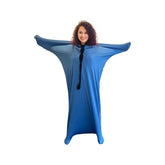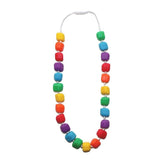Trending Now
Popular Products
Sensory Body Sock
- from £18.99 (£22.79 inc VAT)
- from £18.99 (£22.79 inc VAT)
- (-0%)
- Unit price
- / per
Jellystone Designs Princess & the Pea Pendant - Bright
- £10.83 (£13.00 inc VAT)
- £10.83 (£13.00 inc VAT)
- (-0%)
- Unit price
- / per
Changing Mat & Extra Towelling Layer Bundle
- from £39.99 (£47.99 inc VAT)
£45.98- from £39.99 (£47.99 inc VAT)
- (-19%)
- Unit price
- / per
Need Help?
Email Us
- Black Friday 2025
- Christmas
- Swim
- Clothing
- Bedtime
- Sensory & Activities
- Sensory & Activities
- All Sensory
- Activity Items
- Best Selling
- Guides & Advice
![]()
- Learning
- Daily Living
- Daily Living
- All In The Home
- Best Selling
- In The Home Guides & Support
![]()
- Toileting
- Out & About
- Teens+
- Condition
- Brands
- Help
- Help
- Help
The 8 Senses and Sensory Systems
Most people learn about five senses (sight, hearing, touch, taste, smell). For many children and young people, it helps to include three more: vestibular (balance & movement), proprioception (body awareness) and interoception (internal body signals). Understanding these eight can make day-to-day support clearer and more predictable.
Safety note: If you notice sudden changes in vision, hearing, balance, pain, temperature awareness, toileting patterns, or if there’s injury, infection or fainting, seek medical advice. This page offers general guidance only.
How sensory systems work (in brief)
- Plain English: Receptors in the body notice things (light, sound, touch, movement, inside-body messages). Nerves carry those messages to the brain, which filters and makes sense of them so we can respond.
- Medical: Peripheral receptors (e.g. photoreceptors, hair cells, mechanoreceptors, muscle spindles, visceral afferents) transduce stimuli to neural signals. Ascending pathways relay to subcortical structures and primary/associative cortices where integration, modulation and motor planning occur.
1) Vision (Sight)
- Plain English: What we see — light, colour, shape, movement, and clutter.
- Medical: Light hits the retina (rods & cones) → optic nerve → thalamus → visual cortex for processing of contrast, colour and motion.
Common differences: sensitivity to bright light or glare; visual crowding; difficulty finding items in clutter; fatigue from visual tasks.
Support ideas: reduce visual “busy-ness”, use clear contrasts and simple layouts; try low-arousal lighting for calmer spaces; offer visual schedules where helpful.
2) Hearing (Auditory)
- Plain English: Sounds around us — speech, background hum, sudden noises (hand dryers, alarms).
- Medical: Sound waves → middle ear ossicles → cochlear hair cells → auditory nerve → brainstem nuclei → auditory cortex; filtering of frequency, intensity and timing cues.
Common differences: overwhelm in noisy spaces; startle at sudden sounds; difficulty filtering background noise.
Support ideas: plan for “noisy hotspots”, pre-warn before loud tasks; targeted use of ear protection (not all day): Hilka Ear Defenders, Hilka Junior, Flare Calmer Kids. See Auditory Sensory Needs.
3) Touch (Tactile)
- Plain English: Skin feel — light touch, deep pressure, vibration, temperature, pain.
- Medical: Cutaneous mechanoreceptors (Merkel, Meissner, Pacinian, Ruffini), thermoreceptors and nociceptors → dorsal column–medial lemniscus & spinothalamic pathways → somatosensory cortex.
Common differences: avoids messy textures or certain fabrics; seeks strong squeezes; distracted by labels/seams.
Support ideas: choose soft, breathable clothing; offer predictable deep-pressure input (short, supervised): weighted products, quiet fidgets.
4) Taste (Gustatory)
- Plain English: Flavours — sweet, salty, sour, bitter, savoury (umami), and temperature/texture influences.
- Medical: Taste buds (cranial nerves VII, IX, X) → nucleus tractus solitarius → thalamus → insula/frontal operculum; integration with olfaction and trigeminal input.
Common differences: strong likes/dislikes; gags with textures; avoids minty pastes.
Support ideas: gradual tasting with small steps; neutral flavours for oral care: Oranurse Unflavoured Toothpaste, Dr Barman’s angled brush (children). See Mealtimes advice.
5) Smell (Olfactory)
- Plain English: Scents and odours — pleasant or overwhelming; often affects taste.
- Medical: Odorants bind receptors in the olfactory epithelium → olfactory bulb → limbic/olfactory cortices; close links with emotion/memory.
Common differences: strong reaction to perfumes/cleaners; food refusal due to smell.
Support ideas: ventilate spaces; use unscented products where possible; introduce new smells gradually.
6) Vestibular (Balance & movement)
- Plain English: Sensing head movement and position — helps balance, posture and eye stability.
- Medical: Semicircular canals (angular acceleration) and otolith organs (utricle/saccule for linear acceleration) → vestibular nuclei → cerebellum/ocular motor pathways for postural and gaze control.
Common differences: seeks spinning/bouncing or avoids feet-off-ground; motion sickness; difficulty with lifts/escalators.
Support ideas: short, planned movement breaks; steady rather than rapid spins; outdoor movement options like Didicar. Keep sessions brief and predictable.
7) Proprioception (Body awareness)
- Plain English: Knowing where body parts are without looking — “how hard to push/squeeze”. Often calming.
- Medical: Muscle spindles (length/velocity) and Golgi tendon organs (tension) with joint/skin receptors → dorsal columns/spinocerebellar tracts → cerebellum & somatosensory cortex; crucial for motor control.
Common differences: uses too much/too little force; bumps into things; seeks pushing, pulling, carrying.
Support ideas: “heavy-work” activities (push, pull, carry safely), brief deep-pressure strategies, weighted products (short, supervised), resistive fidgets.
8) Interoception (Internal body signals)
- Plain English: Messages from inside — hunger, thirst, heart rate, temperature, toileting needs, emotions felt in the body.
- Medical: Visceral afferents from organs/skin & baro/chemoreceptors → spinal/cranial pathways → brainstem & thalamus → insular cortex/anterior cingulate; supports homeostasis and emotion awareness.
Common differences: late recognition of toileting needs; not noticing hunger/thirst/temperature; difficulty naming feelings.
Support ideas: predictable routines for drinks/meals/toileting; simple body-signal check-ins; use timers/visual cues; protect bedding during night training: Peejamas, bedding protection. See Toilet Training and Sleep.
Sensory patterns you might see
- Seeking: looks for strong input (e.g., bouncing, chewing) to feel “just right”.
- Avoiding: reduces or escapes input (e.g., covers ears, avoids messy textures).
- Fluctuating: patterns change with tiredness, illness, stress, environment.
Support usually works best by matching the level of input to the moment, using short, predictable routines and one change at a time.
Glossary of key terms
- Photoreceptors: light-sensing cells in the eye (rods for low light, cones for colour and detail).
- Hair cells (auditory): tiny inner-ear cells that turn sound vibrations into nerve signals.
- Mechanoreceptors: skin receptors that detect touch, pressure or vibration.
- Nociceptors: receptors that signal potential or actual tissue damage (pain).
- Proprioception: the sense of body position and force from muscles, joints and tendons.
- Muscle spindle: a receptor inside muscle that senses stretch and speed of stretch.
- Golgi tendon organ: a receptor at the muscle–tendon junction that senses tension/force.
- Vestibular system: balance organs of the inner ear that detect head movement and position.
- Semicircular canals: vestibular structures that sense rotation (turning the head).
- Otolith organs (utricle/saccule): vestibular structures that sense linear movement and head tilt.
- Interoception: awareness of internal body signals (hunger, heart rate, temperature, toileting cues).
- DCML pathway: dorsal column–medial lemniscus; carries fine touch, vibration and position sense to the brain.
- Spinothalamic tract: pathway carrying pain and temperature signals to the brain.
- Sensory modulation: the brain’s filtering/tuning of input so we can focus and respond appropriately.
- Hyper-/hypo-sensitivity: “over-responsive” (too strong) or “under-responsive” (too weak) reactions to sensory input.
Helpful products & pages
- Quiet fidgets — “busy hands” tools for regulation and waiting times
- Weighted products — short, supervised deep-pressure input
- Low-arousal lighting — calm visual environments
- Auditory Sensory Needs — practical sound strategies
- Mealtimes • Toilet Training • Sleep
Funding & budgets
- Potential funding options for families
- Digital catalogues to compare options by category
Need advice?
Email enquiries@fledglings.org.uk with age, settings (home/school/community) and which senses are most challenging. We’ll suggest options that fit your budget. We accept Purchase Orders. UK delivery from £4.99.
Support our work
Donate to Fledglings to help us keep advice free and prices fair.
Related
Last reviewed: 13 September 2025
- Choosing a selection results in a full page refresh.








